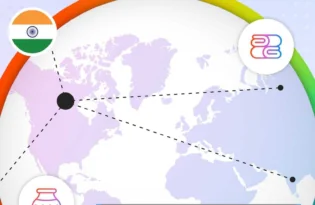Beyond Tariffs: India’s Manufacturing Moment and What it Means for Exporters
India’s exporters are no longer just tariff survivors—they’re strategic movers in a changing global market. Discover how they’re tapping new demand, solving for speed and scale, and unlocking smarter cross-border growth with better financial tools.

India is experiencing a pivotal transformation, creating unprecedented opportunities for exporters to scale globally despite shifting international trade dynamics. As global businesses seek reliable partners and diversified supply chains, India is emerging as a trusted hub for manufacturing and exports.
For example, Tirupur’s textile exporters are celebrating a remarkable turnaround after years of struggle. Orders from global giants are flooding in, pushing exports up 13% in just five months. Meanwhile, a recent article stated that Moradabad’s home decor manufacturers are riding the wave of America’s $141 billion home decor market, with small businesses scaling from minimal sales to thousands of units per month.
The proof is in the numbers. According to a 2025 report, India is on track to export products worth over $820 billion. Industries such as textiles and home decor are experiencing rapid growth, with demand increasing more than anticipated just a few years ago. It’s a great time for Indian makers to shine globally.
The Evolving Global Manufacturing Landscape: Gateway to Growth For Exporters
As global supply chains evolve in response to economic pressures, tariffs, and policy shifts, India’s manufacturing sector is emerging as a resilient alternative in the global marketplace.
Why the World is Looking to India Now
Global supply chains are transforming rapidly. Companies worldwide are actively diversifying their sourcing strategies, seeking partners who offer consistent quality, competitive pricing, and long-term reliability. The impact of tariffs on traditional trade routes has accelerated this shift, creating new opportunities for agile manufacturers.
This shift is creating exciting opportunities for Indian manufacturers. They are perfectly positioned to meet global demand with growing production capacity, improved technology, and a focus on quality. Global buyers are eager to partner with suppliers offering stability, scalability, and competitive pricing — all strengths India has built on.
India’s Manufacturing Edge: What Sets Indian Exporters Apart
India possesses distinct competitive advantages, positioning it as a significant player in the evolving global manufacturing ecosystem.
India’s Competitive Advantages in Action
India’s manufacturing momentum continues to build strength, with total exports estimated to grow by 5.5% in FY 2024-25, reaching $820.93 billion. This growth comes despite global headwinds and shifting tariff landscapes, demonstrating the sector’s underlying resilience and competitive positioning.
Key advantages that set India apart in the global marketplace include:
- Skilled workforce excellence: India’s technical expertise combined with cultural adaptability enables manufacturers to serve diverse global markets effectively while managing multi-currency transactions through platforms like Payoneer.
- Domestic market advantage: The large local market provides testing grounds and economies of scale, reducing per-unit costs significantly.
- Infrastructure transformation: From dedicated freight corridors to modernized ports, logistics costs are dropping while delivery speeds increase.
- Government support that delivers: Production-linked incentives are attracting investments, streamlined compliance is cutting red tape, and industrial clusters are creating efficient ecosystems.
These aren’t just policy announcements; they’re operational realities helping manufacturers compete globally with renewed confidence.
High-Growth Export Categories: Where Exporters should Focus
Several Indian manufacturing sectors are particularly well-positioned to capture expanding global market share.
Top Performing Sectors for Smart Exporters
The home decor industry exemplifies potential, valued at $25.50 billion in 2024 and projected to reach $40.80 billion by 2033. Indian artisans combine traditional craftsmanship with contemporary designs, creating products resonating with global consumers seeking unique, sustainable options. With rising demand for ethically made and story-rich pieces, India is fast becoming a preferred sourcing destination for premium home decor worldwide.
According to a recent report by IBEF, textiles remain a cornerstone sector, contributing 2.3% to GDP, 13% to industrial production, and 12% to exports. The industry moves beyond basic garments to technical textiles, sustainable fabrics, and fashion-forward designs commanding premium prices. India is also the world’s second-largest producer of textiles and garments, reinforcing its strategic importance in the global fashion and lifestyle supply chain. Home textiles show particular promise, valued at $9.60 billion in 2024, expected to reach $15.36 billion by 2029.
The kitchenware and household products sector is also experiencing robust growth, driven by increasing consumer demand for functional, aesthetically pleasing, and competitively priced items. In 2024, the Indian kitchenware market reached $6.30 billion and is projected to grow at a CAGR of 6.1% to $11.30 billion by 2033.
Similarly, a recent report projects the tableware market to grow by $376.9 million from 2024 to 2029, at a compound annual growth rate (CAGR) of 4.8%. Rising disposable incomes, urbanization, and a growing preference for modular kitchens and sustainable products fuel this expansion.
Smart Strategies to Navigate Market Changes
India’s manufacturing exports continue to rise despite global headwinds. Forward-thinking manufacturers are implementing specific strategies to capitalize on emerging opportunities while managing the impact of global trade shifts and tariffs..
Optimize Supply Chains for Success
- Embrace smart manufacturing: Implement IoT sensors, automated systems, and data analytics to identify inefficiencies and accelerate production. Companies winning major export contracts view technology as essential for competing globally, not a luxury.
- Build local supplier networks: Develop strong relationships with nearby suppliers to reduce costs, shorten delivery times, and lower carbon emissions – all while maintaining better control over quality.
- Leverage digital tools: From CAD software for faster design to ERP systems for smoother operations, technology streamlines every step. Real-time inventory tracking and predictive maintenance keep you ahead of the competition.
Diversify Markets to Reduce Risk
India is responding smartly to the tariff changes in the global market by selling to more countries, not just a few. This is called market diversification. It helps reduce risk. If one country buys less, Indian exporters still have many other buyers. For example, India is now selling more to countries in Africa, the Middle East, and Latin America, instead of depending mainly on the US and Europe.
- Explore emerging destinations: Target growing markets in Africa, the Middle East, and Latin America alongside established markets. Each region offers unique opportunities for different product categories.
- Adapt products for local preferences: Different markets demand different specifications. Indian manufacturers can leverage their flexibility to customize offerings while maintaining cost efficiency.
- Build service capabilities: Many manufacturers are adding value through design services, technical support, and after-sales service. These complementary offerings help differentiate products in competitive markets while using the same payment infrastructure, with tools like Payoneer’s multi-currency accounts to manage all international transactions seamlessly.
Emerging Trade Corridors for Indian Manufacturers: Pathways to Global Expansion
Diversification into emerging corridors provides both risk mitigation and growth opportunities for Indian manufacturers navigating tariff impacts.
Beyond Traditional Markets
UK-India momentum will continue with the Free Trade Agreement saving £400 million annually. British buyers appreciate Indian quality while exporters benefit from simplified procedures and reduced tariffs.
ASEAN opportunities will expand through deeper partnerships. Geographic proximity and complementary economies create natural synergies.
Japan-India’s partnership demonstrates depth, with top Japanese companies contributing significantly. EU market potential remains significant as European buyers seeking diversification find Indian manufacturers offer capability, capacity, and compliance.
Financial Tools That Power Export Success
As India’s manufacturing sector expands under initiatives like ‘Make in India’ and ‘Aatmanirbhar Bharat,’ Payoneer provides tailored financial solutions that address the unique needs of SMBs:
- Streamlined Cross-border Transactions: Traditional international payments often involve high fees and delays. Payoneer provides a platform that enables Indian exporters to receive payments in multiple currencies efficiently through virtual receiving accounts with seamless auto-withdrawal of funds from Payoneer to your local Indian bank account. This helps reduce transaction costs and improves cash flow, critical when navigating tariff-impacted pricing.
- Supports Global Expansion: By partnering with global marketplaces like Amazon, eBay and Walmart, Payoneer helps Indian manufacturers tap into new markets. This integration facilitates seamless transactions and broadens customer reach.
- Compliance and Security: Payoneer operates as a fully regulated entity in major global financial hubs, working closely with local regulatory bodies to maintain licenses and approvals across markets including the United States, Europe, the United Kingdom, Hong Kong, Japan, Singapore, and Australia ensuring compliance with global financial standards, providing Indian businesses with secure and reliable payment solutions.
- Localized Support: Understanding the local business environment, Payoneer offers customer-centric services tailored to Indian exporters, including multilingual support and region-specific solutions.
Conclusion: Positioning for Long-term Success
Indian exporters stand at a crucial juncture. Despite the global market’s uncertainty and evolving tariff landscapes, opportunities abound for those ready to act strategically. By improving their product development process, expanding sales to more countries, and utilizing smart payment tools, they can become stronger and more successful.
Success requires three key elements:
- Operational excellence through technology and efficiency
- Market diversification to reduce dependency risks
- Robust financial infrastructure for seamless global transactions
The global market is actively seeking trusted manufacturing partners who deliver quality, innovation, and value. Indian manufacturers are perfectly positioned to meet this demand.
The big question isn’t if you should grow your business globally — it’s how soon can you take advantage of this exciting time in India’s manufacturing journey?
Disclaimer
Nothing herein should be construed as if Payoneer Inc. or its affiliates are soliciting or inviting any person outside the jurisdiction where it operates/is licensed to engage in payment services provided by Payoneer Inc. or its affiliates, unless permitted by applicable laws. Any products/services availability are subject to customer’s eligibility. Not all products/services are available in all jurisdictions in the same manner. Depending on your eligibility, you may be offered with the Corporate Purchasing Mastercard, issued by First Century Bank, N.A., under a license by Mastercard® and provided to you by Payoneer Inc., or the Payoneer Business Premium Debit Mastercard®, issued and provided from Ireland by Payoneer Europe Limited under a license by Mastercard. The Payoneer Business Premium Debit Mastercard® cannot be used at merchants or ATMs in Hong Kong or for HKD payments. If you are located in the EEA, all Payoneer Services will be provided to you by Payoneer Europe Limited, trading as Payoneer and regulated by the Central Bank of Ireland.
The information in this document is intended to be of a general nature and does not constitute legal advice. While we have endeavored to ensure that the information is up to date and correct, we make no representations or warranties of any kind, express or implied, about the completeness, accuracy, reliability or suitability of the information. In no event will we be liable for any loss or damage including without limitation, indirect or consequential loss or damage, or any loss or damage whatsoever incurred in connection with the information provided.
Related resources
Latest articles
-
Planning to hire employees in France? Here’s a quick guide
Looking to hire employees in France for your U.S. company? Learn about employment in France and how Payoneer Workforce Management makes it simple to hire in France.
-
Planning to hire employees in Spain? Here’s a quick guide
Are you looking to hire employees in Spain? Learn about employment in Spain and how Payoneer Workforce Management can help American companies hiring in Spain.
-
How to hire employees in the Netherlands
Looking to hire employees in the Netherlands for your U.S. company? Learn about employment in the Netherlands and how Payoneer Workforce Management can help hire in the Netherlands.
-
How to hire employees in Australia
Looking to hire employees in Australia for your US company? Learn about employment in Australia and how Payoneer Workforce Management makes it easy to hire in Australia.
-
Planning to hire employees in Germany? Here’s a quick guide
Are you looking to hire employees in Germany? Learn about hiring in Germany and how Payoneer Workforce Management can help U.S. companies hiring in Germany.
-
Planning to hire employees in the Philippines? Here’s a quick guide
Wondering how an American company hires employees in the Philippines? Our guide covers how to hire employees in the Philippines and how we can help.
Disclaimer
Nothing herein should be construed as if Payoneer Inc. or its affiliates are soliciting or inviting any person outside the jurisdiction where it operates/is licensed to engage in payment services provided by Payoneer Inc. or its affiliates, unless permitted by applicable laws. Any products/services availability are subject to customer’s eligibility. Not all products/services are available in all jurisdictions in the same manner. Depending on your eligibility, you may be offered with the Corporate Purchasing Mastercard, issued by First Century Bank, N.A., under a license by Mastercard® and provided to you by Payoneer Inc., or the Payoneer Business Premium Debit Mastercard®, issued and provided from Ireland by Payoneer Europe Limited under a license by Mastercard. The Payoneer Business Premium Debit Mastercard® cannot be used at merchants or ATMs in Hong Kong or for HKD payments. If you are located in the EEA, all Payoneer Services will be provided to you by Payoneer Europe Limited, trading as Payoneer and regulated by the Central Bank of Ireland.
The information in this document is intended to be of a general nature and does not constitute legal advice. While we have endeavored to ensure that the information is up to date and correct, we make no representations or warranties of any kind, express or implied, about the completeness, accuracy, reliability or suitability of the information. In no event will we be liable for any loss or damage including without limitation, indirect or consequential loss or damage, or any loss or damage whatsoever incurred in connection with the information provided.














